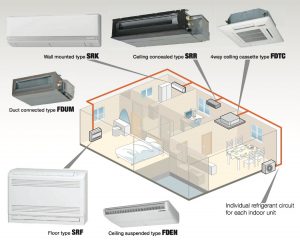Exploring the Various Types of AC Systems in Australia
When it comes to staying comfortable in the scorching Australian summers or managing the occasional chilly nights, air conditioning (AC) systems play a pivotal role. With the vast and diverse climate across this continent, it’s essential to have a cooling and heating solution that suits your specific needs. In this comprehensive guide, we’ll delve into the different types of AC systems commonly used in Australia to help you make an informed choice.
Ducted Air Conditioning Systems
Ducted air conditioning systems are a popular choice among Australian homeowners due to their efficiency and ability to cool or heat an entire house. Here’s a closer look at their features and advantages:

Features:
Centralized Cooling and Heating: Ducted AC systems consist of a central unit that is connected to a network of ducts installed throughout your home. This allows for even distribution of cool or warm air in every room.
Zoning Options: You can create different zones within your home, each with its own thermostat control. This enables you to customize the temperature in various areas to suit individual preferences.
Quiet Operation: Ducted systems are designed for minimal noise, ensuring a peaceful indoor environment.
Energy Efficiency: These systems are often highly energy-efficient, which can result in lower utility bills over time.
Advantages:
Whole-House Comfort: Ducted AC systems provide consistent comfort throughout your entire home, making them ideal for large properties.
Aesthetic Appeal: They are concealed within the ceiling or walls, leaving no visible equipment, which can enhance the aesthetics of your home.
Customization: The zoning feature allows you to save energy by only cooling or heating occupied rooms.
Longevity: Properly maintained ducted systems can last for many years, providing a reliable cooling and heating solution.
Split System Air Conditioners
Split system air conditioners are a versatile and cost-effective choice for both cooling and heating. They consist of two main components – an indoor unit and an outdoor compressor. Here’s what you need to know about them:
Features:
Two-Part System: Split systems comprise an indoor unit installed on the wall or ceiling and an outdoor unit placed outside the house.
Single and Multi-Zone Options: You can choose between single-zone systems, suitable for a single room, or multi-zone systems that can cool or heat multiple rooms.
Remote Control: Most split systems come with a remote control for convenient temperature adjustments. For types of air conditioners available see this.

Heat Pump Functionality: Many split systems offer reverse cycle technology, allowing them to provide both cooling and heating functions.
Advantages:
Affordability: Split systems are often more budget-friendly than ducted systems, making them a popular choice for smaller homes or single rooms.
Ease of Installation: They are relatively easy to install, and the absence of ductwork reduces installation costs.
Energy Efficiency: Many split systems are energy-efficient, helping you save on energy bills.
Individual Control: With multi-zone systems, you can control the temperature in different rooms independently.
Evaporative Cooling Systems
Evaporative cooling systems are well-suited for Australia’s dry and hot climate. They work by drawing in warm air, passing it through water-saturated pads, and releasing cooled air into your living space. Let’s explore their features and benefits:
Features:
Natural Cooling: Evaporative systems use the natural process of evaporation to cool the air, making them eco-friendly and cost-effective.
Low Energy Consumption: They consume less electricity compared to traditional air conditioning systems, which is a significant advantage in Australia’s energy-conscious environment.
Healthy Air Quality: Evaporative coolers add moisture to the air, which can be beneficial for respiratory health, especially in dry climates.
Low Maintenance: These systems have fewer complex components, resulting in lower maintenance costs.
Advantages:
Energy Efficiency: Evaporative coolers are highly energy-efficient and can significantly reduce your cooling costs.
Fresh Air Circulation: They constantly bring in fresh outdoor air, providing better indoor air quality.
Affordability: Initial installation costs are usually lower than many other AC systems, making them accessible to a wide range of budgets.
Environmentally Friendly: Evaporative cooling systems have a lower carbon footprint compared to refrigerated air conditioners.
Reverse Cycle Air Conditioners
Reverse cycle air conditioners, also known as heat pumps, are versatile systems capable of both cooling and heating. They are particularly popular in regions with varying temperatures. Let’s explore their features and benefits:
Features:
Year-Round Comfort: Reverse cycle AC units can cool your home in summer and provide efficient heating in winter.
Efficient Heating: They are highly efficient at converting electricity into heat, making them cost-effective for heating during colder months.
Temperature Control: Most reverse cycle systems come with precise temperature control settings for optimal comfort.
Quiet Operation: These systems are designed for quiet operation, ensuring minimal disruption.
Advantages:
All-Season Solution: Reverse cycle systems provide year-round comfort, eliminating the need for separate cooling and heating systems.
Energy Efficiency: They are energy-efficient and can save you money on heating costs.
Low Environmental Impact: Heat pumps produce fewer greenhouse gas emissions compared to traditional heating methods.
Versatility: They are suitable for homes of all sizes, from apartments to large houses.
Conclusion
Choosing the right AC system for your Australian home is a crucial decision that depends on factors such as climate, budget, and personal preferences. Whether you opt for a ducted system for whole-house comfort, a split system for individual room control, an evaporative cooler for energy efficiency, or a reverse cycle air conditioner for year-round versatility, you’ll find a solution that suits your needs. Make an informed choice, and enjoy a comfortable and climate-controlled living space that adapts to the ever-changing Australian weather.


